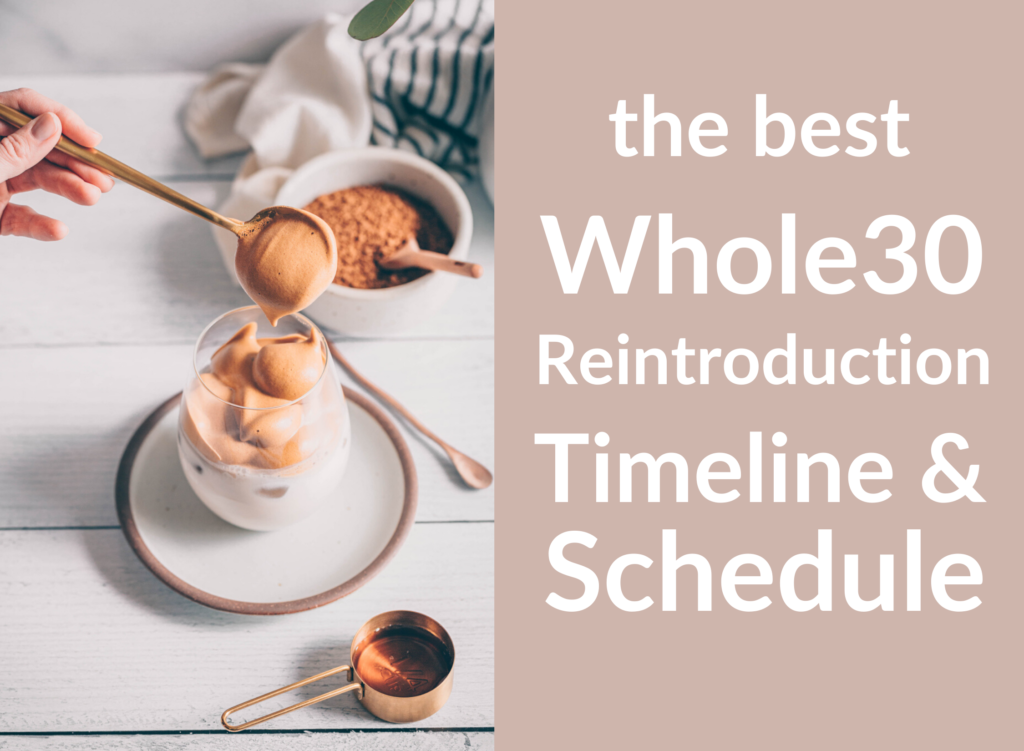Whether you’re just starting your Whole30 or you’re nearing the end, it’s important not to forget about reintroduction. The right reintroduction schedule will give you a ton of insight on what works for your body and what doesn’t!

There are a few different philosophies on the best Whole30 reintroduction schedule. Read on to find out what reintroduction is and how to put together the best reintroduction schedule for you!
What does Whole30 reintroduction mean?
As an AIP blogger, I know a thing or two about reintroduction. A Whole30 reintroduction isn’t a different concept than any other reintroduction phase. So what is reintroduction?
Simply speaking, reintroduction is the final phase of an elimination diet. After you’ve eliminated certain food groups that you suspect are causing health issues, you then need to reintroduce these food groups. Reintroduction is done slowly, systematically, and with careful attention.
Why do I need to reintroduce anything?
Remember that an elimination diet isn’t intended to be a permanent diet. In fact, eliminating entire food groups for too long can have negative consequences such as:
- Cultivating an unhealthy relationship with food (source)
- Decreasing your body’s ability to digest certain food groups, such as carbohydrates after a low-carb diet (source) or meat after veganism
- Causing undue stress as you try to work around a limited diet
Your elimination diet should last about 3-4 weeks or until overwhelming symptoms fade away. After that time, you should begin systematically reintroducing food groups one at a time. The benefits of successful reintroduction include:
- The ability to enjoy a wider variety of foods
- A more diverse gut microbiome
- A more nutrient-dense diet from the inclusion of more foods
- Ability to identify food intolerances (unlike food allergies, intolerances can impact more than just your physical health – problematic-for-you foods can impact your emotional state as well)
The reintroduction phase is where the magic happens! It allows you to create a customized dietary protocol that is perfect for your body, your goals, and your food tolerances. Don’t skip reintroduction, or continue the elimination phase for too long, or you’ll miss out on the true power of the Whole30!
How to do Whole30 reintroduction
A Whole30 reintroduction will look different for everyone. The Whole30 website offers two common options: the Fast Track and the Slow Roll.
With the Fast Track option, you introduce each food group on a careful schedule, leaving a few days between reintroductions to check for symptoms. This is how you find out what foods actually cause unpleasant symptoms.
Note that leaving a few days between reintroductions is critical. Reactions to a certain food could take several days–for example, that wheat wrap you ate on Tuesday might not cause you any issues until Thursday. If you also reintroduced dairy on Wednesday, you wouldn’t know whether it was the gluten or the dairy that made you feel crappy!
With the Slow Roll option, you continue to follow a Whole30 diet and simply introduce eliminated food groups as you feel like it. For example, you may choose to enjoy a glass of wine with dinner on Tuesday, and a piece of pizza on Thursday.
Fast Track vs. Slow Roll
By choosing the fast track option, you’re able to really pinpoint what foods are causing distress. It also takes significantly less time to complete! However, it may mean you constantly introduce foods that cause symptoms, leading you to feel unwell more often.
The slow roll option, on the other hand, allows you to eat more intuitively (by intuitively, I mean choosing foods that sound good to you at that moment.) The downside is that it has no set end date, so you could spend months reintroducing things. You also might confuse symptoms if you reintroduce food groups too closely together.
What to look for on a Whole30 reintroduction
As with any elimination diet, the goal of a Whole30 is to make you feel better. Once you feel better, you can start reintroducing foods. An elimination diet is the best way to find out food sensitivities! Don’t skip reintroduction. You could be missing out on lots of amazing food!
Symptoms of food sensitivities or intolerances are difficult to pinpoint because everyone is so different. Ultimately, you need to listen to your body. Here are some common symptoms you should watch for on a Whole30 reintroduction:
- Fatigue/low energy
- Sleep disturbances, such as interrupted sleep
- Digestive issues like gas, bloating, diarrhea, or constipation
- Mood imbalances like irritability, depression, anxiety, or disproportionate reactions
- Muscle aches or soreness, especially out of proportion to activity level
- Overall inflammation, especially headaches, joint pain/stiffness, and migraines (and migraine auras)
- Skin issues like breakouts, flushes, rashes, or dullness
- Allergic flares
These are general symptoms. Be on the lookout for anything that is out of the ordinary for YOU, especially if nothing else has changed in your lifestyle except for the reintroduced food.
Whole30 reintroduction tips
So, how do you make the most out of your Whole30 reintroduction? As someone who’s done a few rounds of elimination diets, these are the strategies I’ve found most helpful for the reintroduction phase!
- Keep a detailed journal. This is easier if you’re doing a fast track, because you might not want to keep a food journal for several months. Keep track of what and when you eat, how you feel before and after, and any other lifestyle factors like exercise, sleep, and stress.
- Keep your lifestyle pretty much the same. A reintroduction phase is not the time to begin a new workout regimen or take that new job with the crazy hours. If too much else changes in your life, you might not be able to tell if any symptoms are due to the reintroduced food.
- Prioritize self care. If a reintroduced food causes fatigue, give yourself some extra rest. If you experience headaches, have some peppermint oil on hand. You’re asking a lot of your body right now!
- Make it fun. Reintroduction should be fun, minus any symptoms! Plan out some meals and try new recipes. What have you been craving that you haven’t been able to enjoy? Now’s the time to break out the overnight oats and plan that chickpea pasta dish.
- When/if you encounter a reaction, remember that Whole30 did not cause it. This may seem like a silly “tip”, but it’s one of the most common questions I get asked in regards to reintroduction. Just because a food didn’t previously cause a reaction you’re now experiencing does not mean you haven’t always had a reaction to that food. Eliminating that food on Whole30 allowed your body to recover a bit, so the reaction is more noticeable once it was reintroduced.
How do I transition from Whole30 to Paleo?
I recommend a transition reintroduction–that is, transitioning from the Whole30 to a slightly more expanded diet. Your diet won’t change that much, but it will still be broader than your elimination diet. Keep adding in foods until you’ve reached a place of food freedom.
The Paleo diet is a common diet for those who want to transition from a Whole30 but still keep their diet anti-inflammatory and nutrient dense. The Paleo diet includes a variety of meat, seafood, vegetables, fruit, nuts and seeds and prioritizes food quality.
Everyone does Paleo differently, and there is no set version. Some people follow a strict Paleo diet based on only what hunters/gatherers would have access to. Others expand their version of Paleo to what early civilizations would have had, like raw dairy and fermented grains.
Your diet will remain pretty much the same from Whole30 to Paleo. The difference really lies in the fact that the Whole30 is a short term, very strict elimination diet, while Paleo is a lifestyle diet. You can loosen the reins and simply use Paleo as the base of your diet. That means you can choose some compliant convenience foods and snacks, and include some baked goods and sweeteners in your life.
Looking for some Paleo recipes for reintroduction? These are some of my fave meals and treats!
- Bang Bang Shrimp Pasta
- Savory Zucchini Waffle Breakfast Sandwiches
- Bacon Cheeseburger Nachos
- Bacon Chocolate Chunk Deep Dish Skillet Cookie
No matter which Whole30 reintroduction schedule you choose, make it personalized for you. The right Whole30 reintroduction schedule will be doable, not stressful, and it will give you insight about your unique body. Whatever you do, don’t skip reintroduction. Make it fun, make it yours, and best of luck!

Leave a Reply